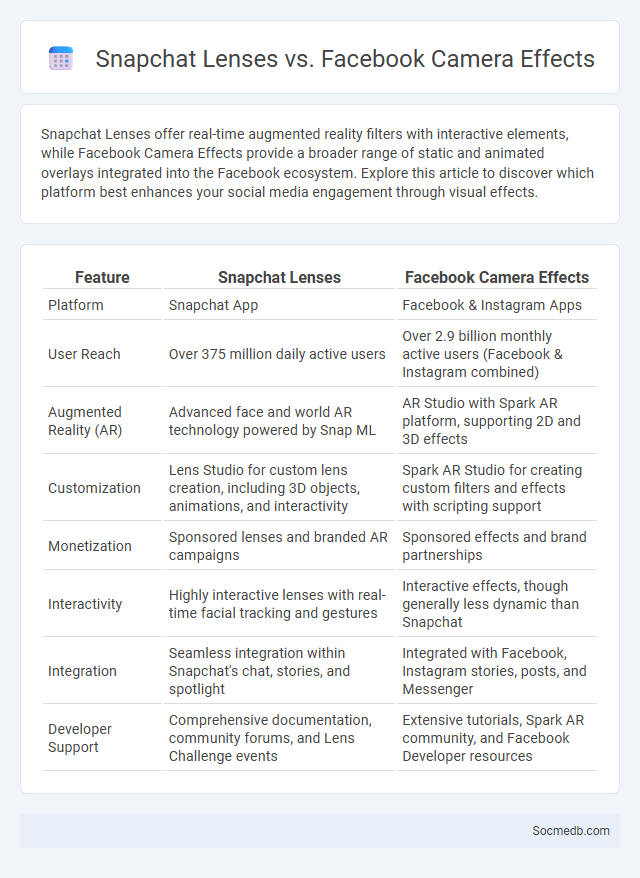
Photo illustration: Snapchat Lenses vs Facebook Camera Effects
Snapchat Lenses offer real-time augmented reality filters with interactive elements, while Facebook Camera Effects provide a broader range of static and animated overlays integrated into the Facebook ecosystem. Explore this article to discover which platform best enhances your social media engagement through visual effects.
Table of Comparison
| Feature | Snapchat Lenses | Facebook Camera Effects |
|---|---|---|
| Platform | Snapchat App | Facebook & Instagram Apps |
| User Reach | Over 375 million daily active users | Over 2.9 billion monthly active users (Facebook & Instagram combined) |
| Augmented Reality (AR) | Advanced face and world AR technology powered by Snap ML | AR Studio with Spark AR platform, supporting 2D and 3D effects |
| Customization | Lens Studio for custom lens creation, including 3D objects, animations, and interactivity | Spark AR Studio for creating custom filters and effects with scripting support |
| Monetization | Sponsored lenses and branded AR campaigns | Sponsored effects and brand partnerships |
| Interactivity | Highly interactive lenses with real-time facial tracking and gestures | Interactive effects, though generally less dynamic than Snapchat |
| Integration | Seamless integration within Snapchat's chat, stories, and spotlight | Integrated with Facebook, Instagram stories, posts, and Messenger |
| Developer Support | Comprehensive documentation, community forums, and Lens Challenge events | Extensive tutorials, Spark AR community, and Facebook Developer resources |
Overview of Augmented Reality Features
Augmented reality (AR) features in social media enhance user engagement by overlaying digital content onto real-world environments through smartphone cameras and AR glasses. These features include interactive filters, virtual try-ons, and 3D animations that create immersive experiences, driving higher user interaction and brand awareness. Your social media presence benefits from AR by offering innovative ways to connect with audiences and boost content appeal.
Snapchat Lenses: Key Functionalities
Snapchat Lenses utilize augmented reality technology to overlay interactive filters and animations on users' faces and surroundings, enhancing real-time photo and video sharing. These lenses leverage facial recognition and motion tracking to create immersive experiences that respond to user expressions and movements. Frequent updates and user-generated content contribute to their dynamic appeal, driving engagement and creative self-expression on the Snapchat platform.
Facebook Camera Effects: Core Capabilities
Facebook Camera Effects offer core capabilities such as augmented reality (AR) filters, interactive 3D objects, and real-time face tracking for immersive user experiences. The platform supports custom effect creation using Spark AR Studio, enabling developers to design unique effects that integrate with Facebook, Instagram, and Messenger. Advanced features include environment mapping, target tracking, and segmentation, enhancing engagement and visual storytelling on social media.
Lenses in Other Social Media Apps
Lenses in other social media apps enhance user engagement by offering augmented reality filters that transform photos and videos with interactive effects. These features drive creativity and personalization, making your content more appealing and shareable across platforms such as Instagram, Snapchat, and TikTok. Leveraging lenses can boost your social presence by increasing visual appeal and encouraging audience interaction.
User Engagement Comparison
User engagement on social media platforms varies significantly, with Instagram boasting an average engagement rate of 1.22%, outperforming Facebook's 0.08% and Twitter's 0.045%. TikTok users demonstrate the highest interaction rates, driven by video content, with engagement often exceeding 5% for popular creators. Metrics such as likes, comments, shares, and time spent provide critical insights into audience behavior and content effectiveness across different platforms.
Creative Tools and Customization Options
Social media platforms offer a wide range of creative tools and customization options to help you craft unique and engaging content. Features like filters, stickers, text overlays, and music integration allow for personalized expression, enhancing the visual appeal of your posts. Customization options extend to profile themes, post formats, and interactive elements, enabling a tailored experience that resonates with your audience and strengthens your online presence.
Platform Accessibility and Device Compatibility
Social media platforms enhance user experience through seamless platform accessibility, supporting a wide range of operating systems including iOS, Android, and Windows. Device compatibility ensures optimal performance on smartphones, tablets, desktops, and smart TVs, facilitating consistent functionality across diverse screen sizes and hardware capabilities. Advanced features like adaptive interfaces and offline modes contribute to uninterrupted social media engagement regardless of device limitations.
Impact on Social Media Marketing
Social media dramatically transforms marketing strategies by enabling precise audience targeting through data analytics and behavioral insights. Platforms like Facebook, Instagram, and TikTok offer businesses cost-effective advertising options that boost brand visibility and customer engagement in real time. User-generated content and influencer collaborations amplify authentic brand messaging, increasing trust and conversion rates across diverse demographics.
Privacy and Data Usage
Protecting your privacy on social media platforms requires careful management of personal data shared online. Understanding the ways companies collect, store, and use your information can help you control access and minimize risks of data breaches or misuse. Reviewing privacy settings regularly ensures that your digital footprint remains secure and aligns with your preferences.
Future Trends in AR Filters and Effects
Future trends in AR filters and effects on social media emphasize hyper-realistic and interactive experiences, powered by advancements in AI and computer vision technology. Enhanced personalization algorithms enable filters to adapt dynamically to individual facial features and environments, increasing user engagement and content creativity. Integration with e-commerce platforms allows seamless virtual try-ons, transforming social media into a powerful tool for digital marketing and immersive shopping experiences.
 socmedb.com
socmedb.com